Phytochemical investigation of Eurycoma longifolia roots collected in Gia Lai province, Viet Nam
From the roots of Eurycoma longifolia, seven compounds including β-carboline-2N-oxide-1-propionic acid (1),
9,10-dimethoxycanthin-6-one (2), β-carboline-1-propionic acid (3), infractine (4), eurylene (5), eurycomanone (6),
14,15-β-hydroxyklaineanol (7) were isolated. Their structures were determined by means of spectroscopic methods
(UV, IR, HR-ESIMS, 1D and 2D NMR). Compound (1) has been isolated for the first time from nature and compound
(4) has been isolated for the first time from Eurycoma longifolia.
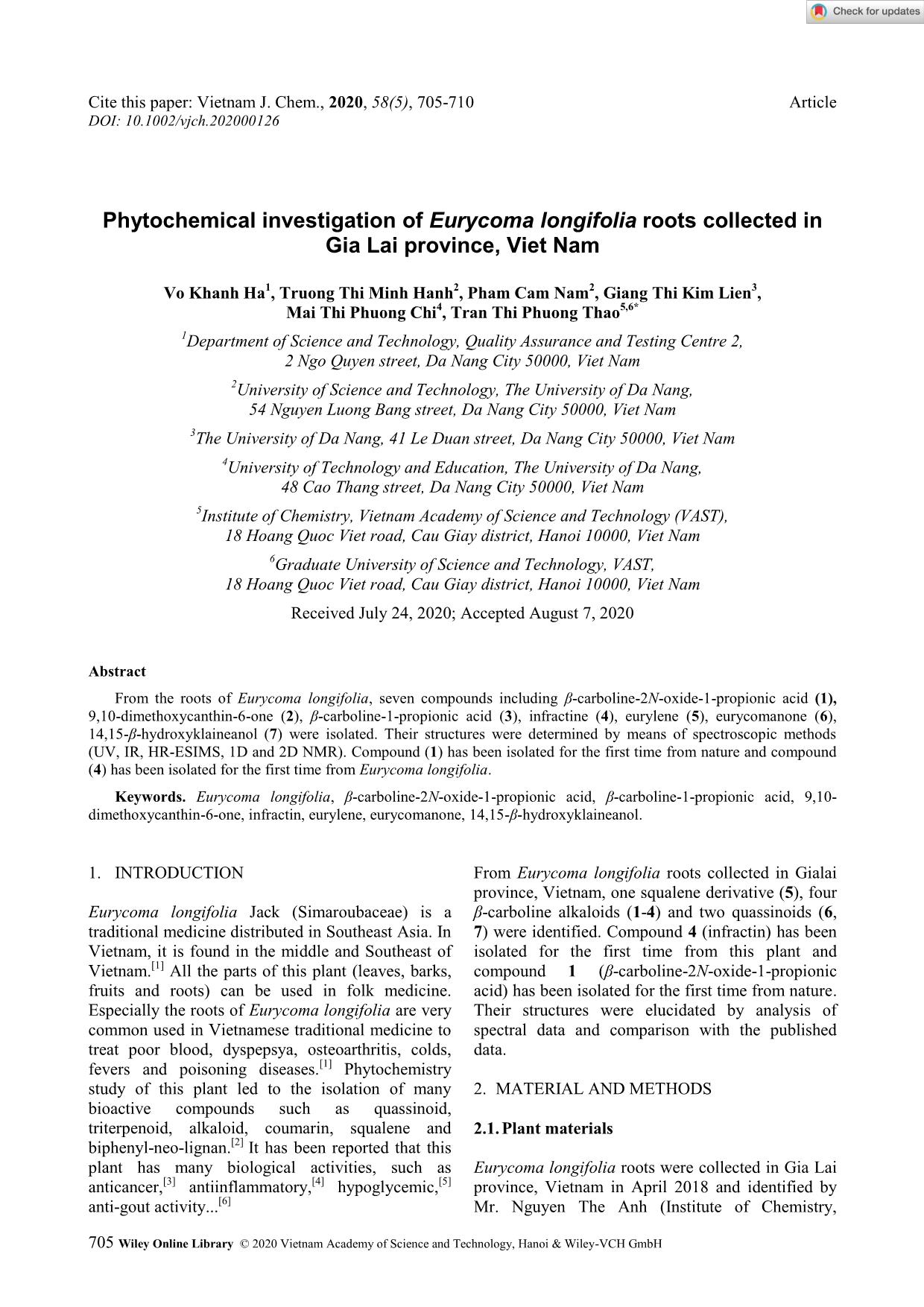
Trang 1
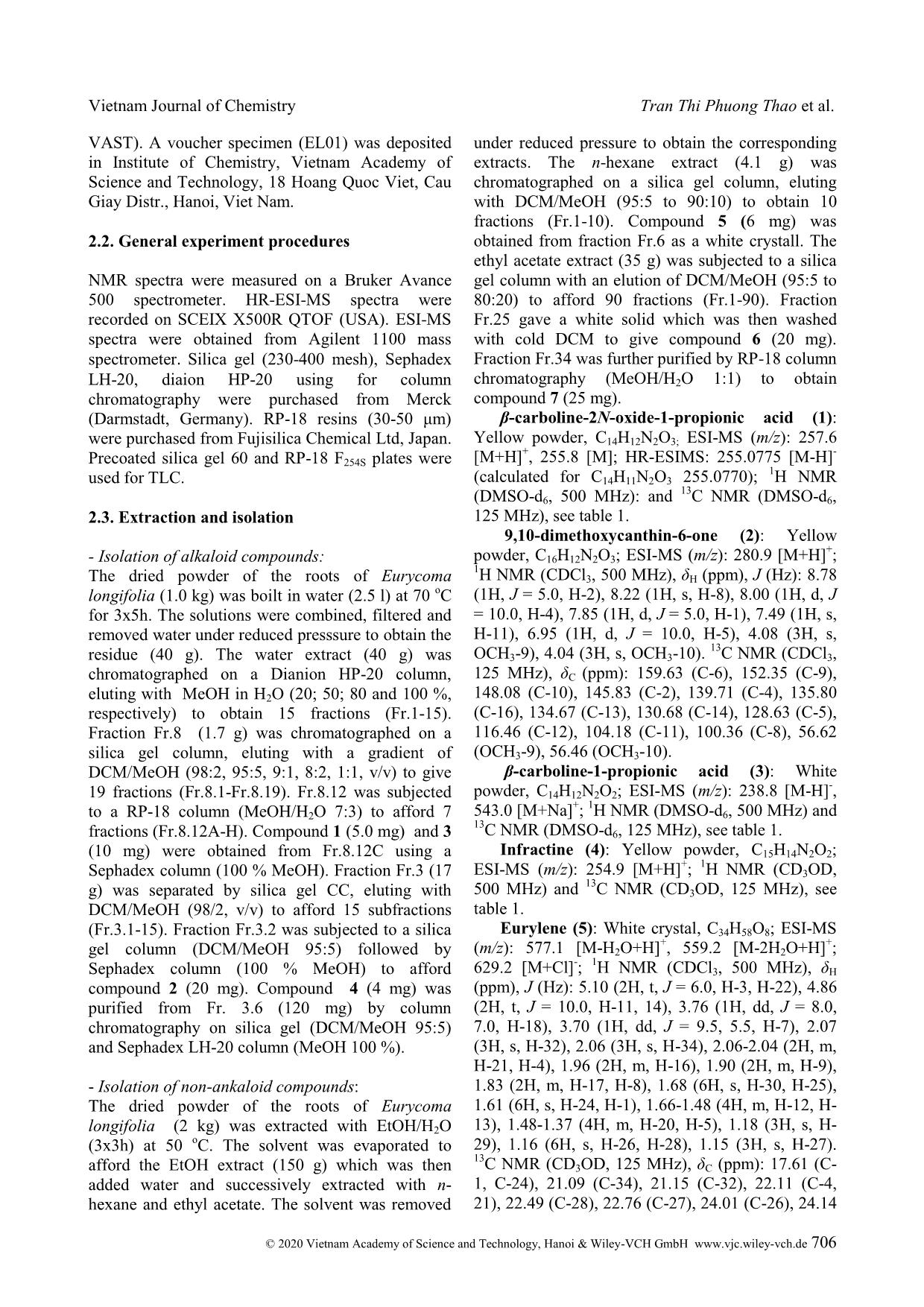
Trang 2
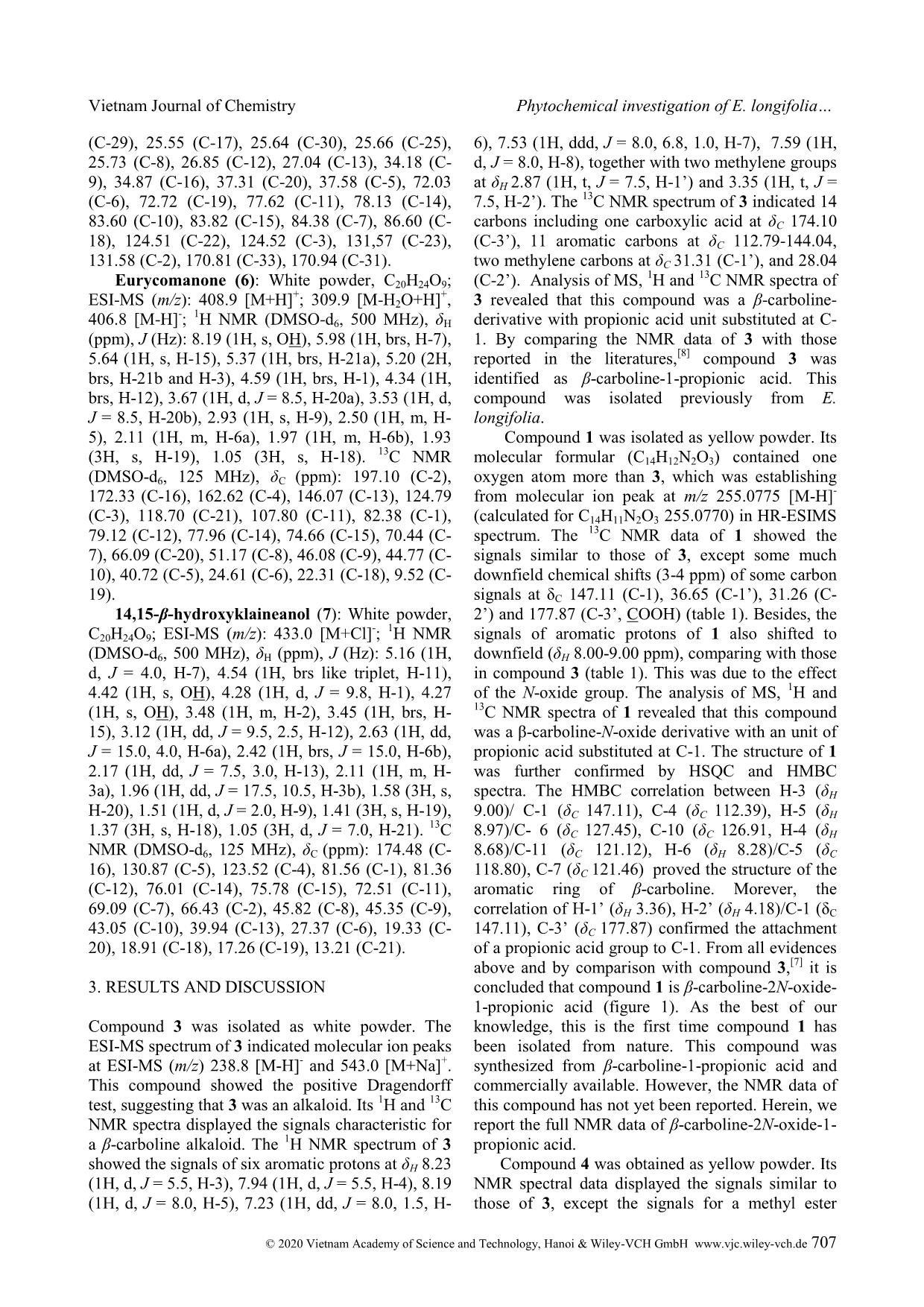
Trang 3
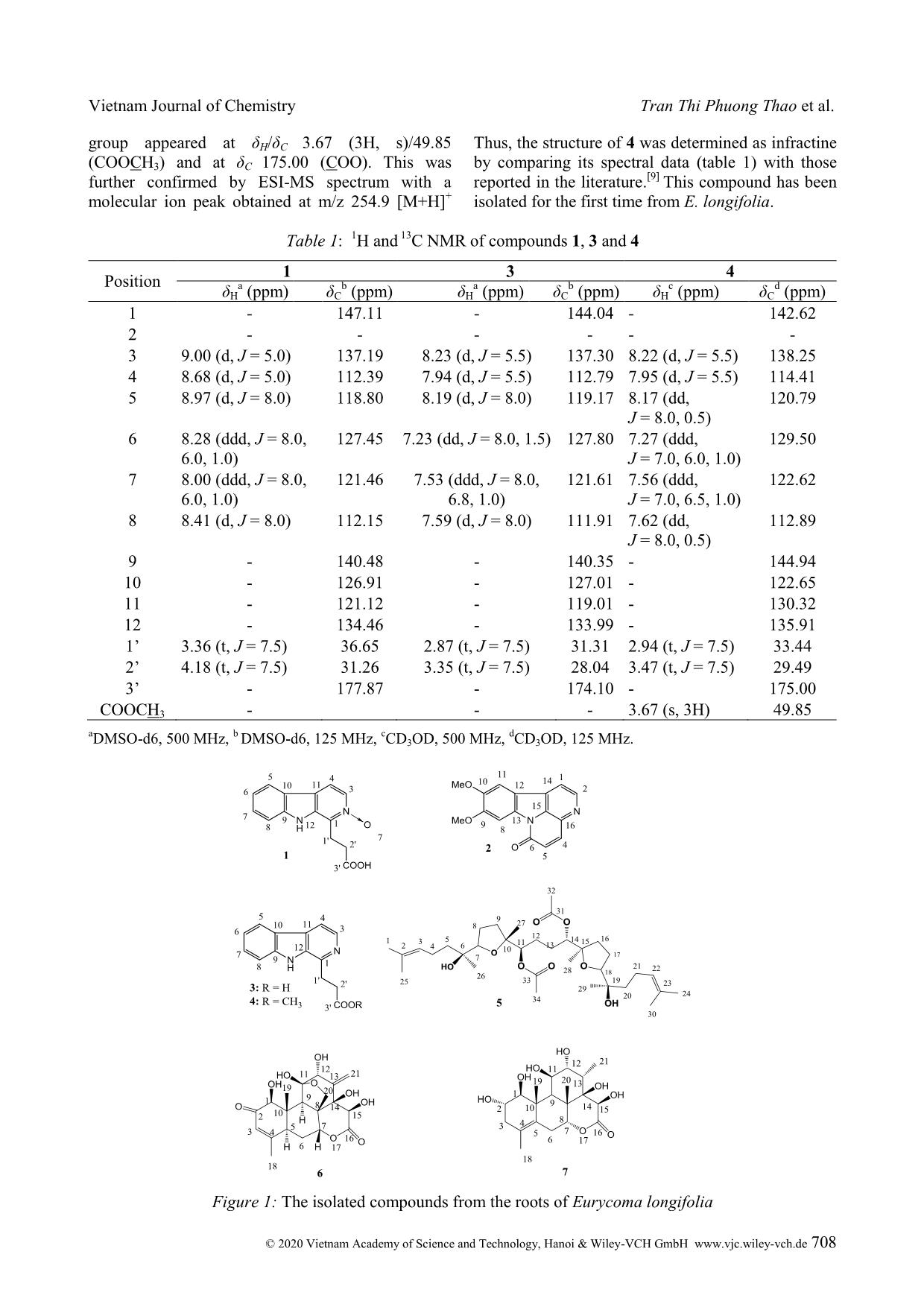
Trang 4
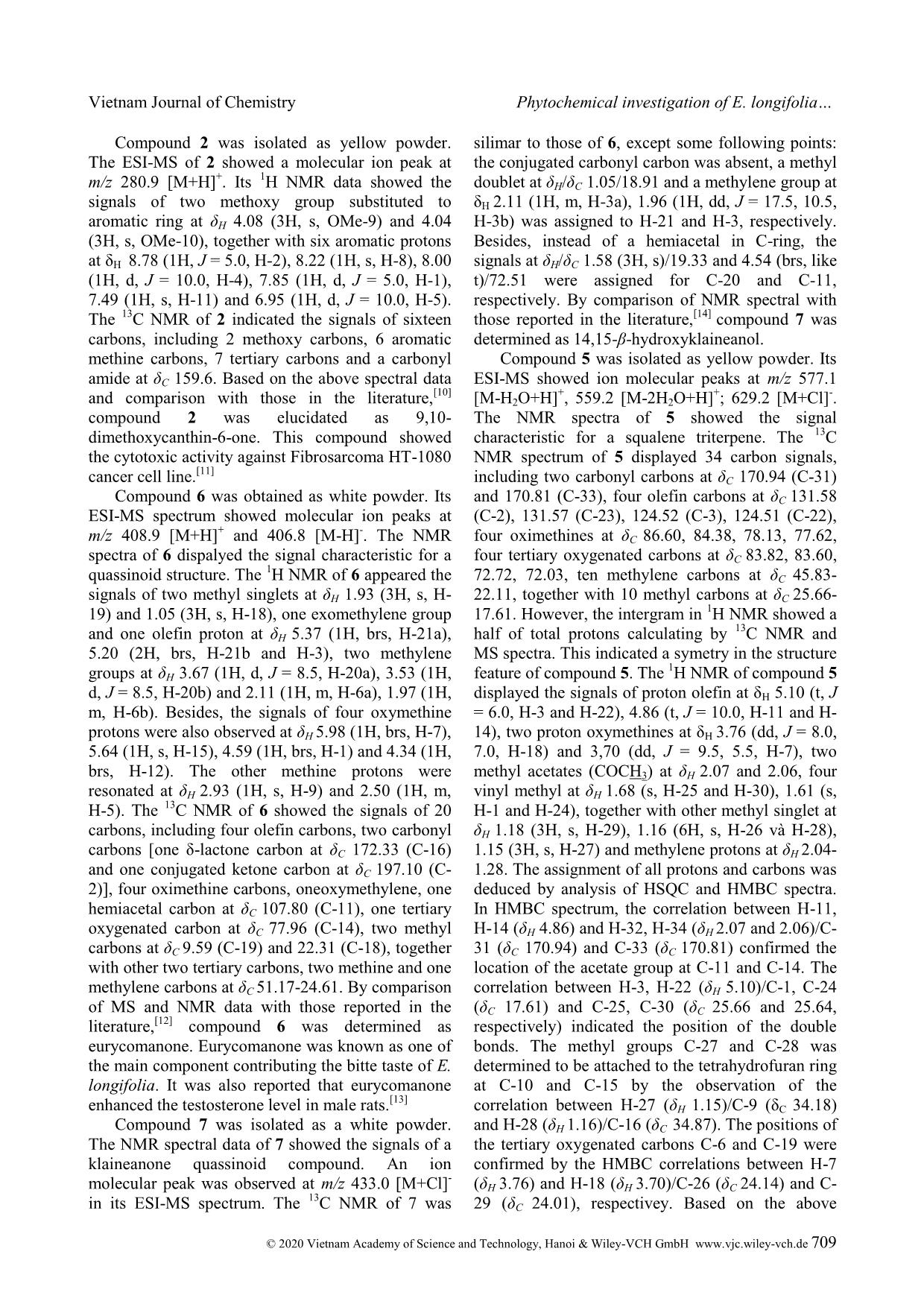
Trang 5
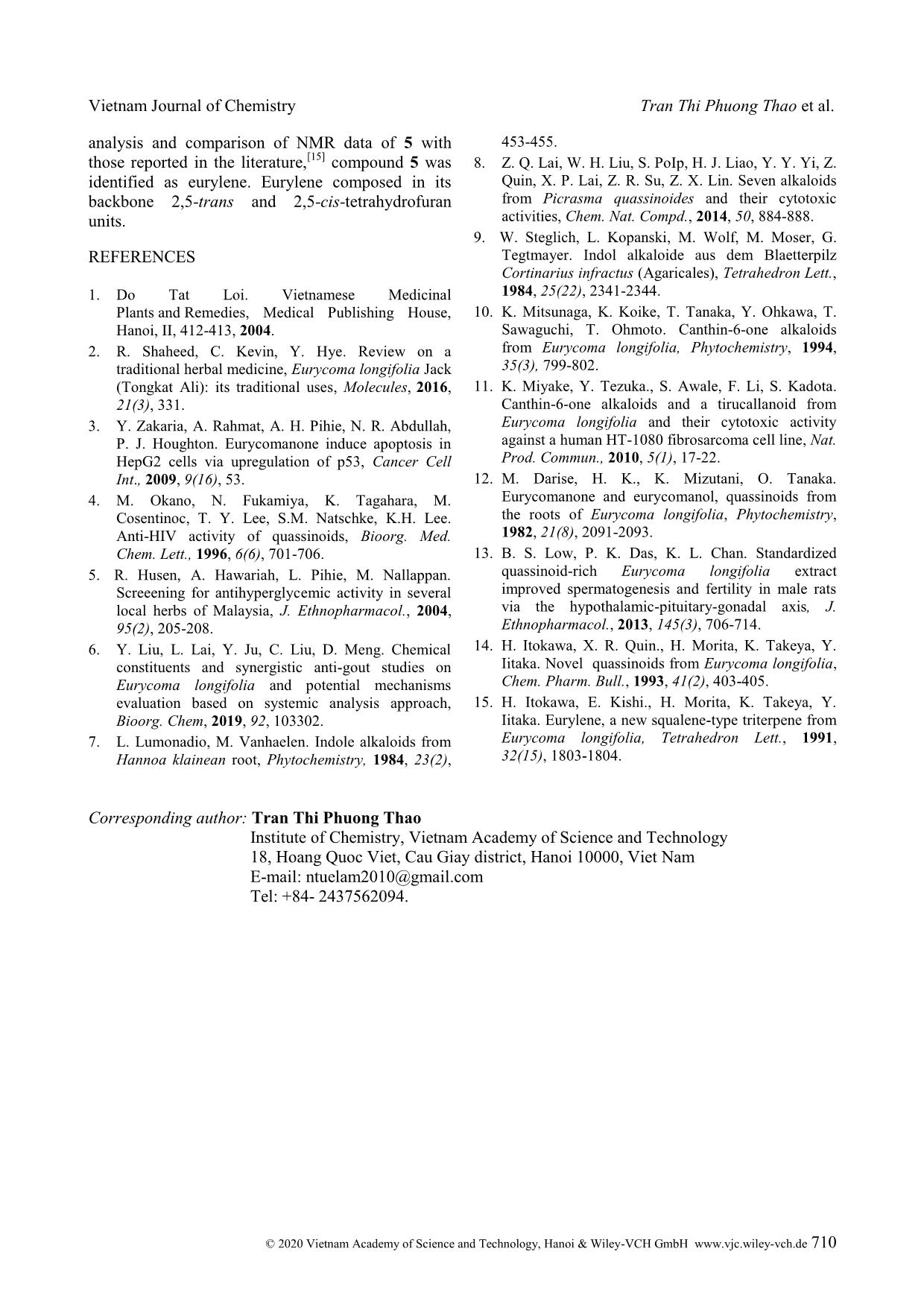
Trang 6
Bạn đang xem tài liệu "Phytochemical investigation of Eurycoma longifolia roots collected in Gia Lai province, Viet Nam", để tải tài liệu gốc về máy hãy click vào nút Download ở trên
Tóm tắt nội dung tài liệu: Phytochemical investigation of Eurycoma longifolia roots collected in Gia Lai province, Viet Nam
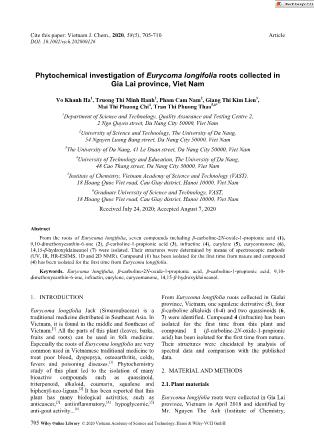
Cite this paper: Vietnam J. Chem., 2020, 58(5), 705-710 Article DOI: 10.1002/vjch.202000126 705 Wiley Online Library © 2020 Vietnam Academy of Science and Technology, Hanoi & Wiley-VCH GmbH Phytochemical investigation of Eurycoma longifolia roots collected in Gia Lai province, Viet Nam Vo Khanh Ha 1 , Truong Thi Minh Hanh 2 , Pham Cam Nam 2 , Giang Thi Kim Lien 3 , Mai Thi Phuong Chi 4 , Tran Thi Phuong Thao 5,6* 1 Department of Science and Technology, Quality Assurance and Testing Centre 2, 2 Ngo Quyen street, Da Nang City 50000, Viet Nam 2 University of Science and Technology, The University of Da Nang, 54 Nguyen Luong Bang street, Da Nang City 50000, Viet Nam 3 The University of Da Nang, 41 Le Duan street, Da Nang City 50000, Viet Nam 4 University of Technology and Education, The University of Da Nang, 48 Cao Thang street, Da Nang City 50000, Viet Nam 5 Institute of Chemistry, Vietnam Academy of Science and Technology (VAST), 18 Hoang Quoc Viet road, Cau Giay district, Hanoi 10000, Viet Nam 6 Graduate University of Science and Technology, VAST, 18 Hoang Quoc Viet road, Cau Giay district, Hanoi 10000, Viet Nam Received July 24, 2020; Accepted August 7, 2020 Abstract From the roots of Eurycoma longifolia, seven compounds including β-carboline-2N-oxide-1-propionic acid (1), 9,10-dimethoxycanthin-6-one (2), β-carboline-1-propionic acid (3), infractine (4), eurylene (5), eurycomanone (6), 14,15-β-hydroxyklaineanol (7) were isolated. Their structures were determined by means of spectroscopic methods (UV, IR, HR-ESIMS, 1D and 2D NMR). Compound (1) has been isolated for the first time from nature and compound (4) has been isolated for the first time from Eurycoma longifolia. Keywords. Eurycoma longifolia, β-carboline-2N-oxide-1-propionic acid, β-carboline-1-propionic acid, 9,10- dimethoxycanthin-6-one, infractin, eurylene, eurycomanone, 14,15-β-hydroxyklaineanol. 1. INTRODUCTION Eurycoma longifolia Jack (Simaroubaceae) is a traditional medicine distributed in Southeast Asia. In Vietnam, it is found in the middle and Southeast of Vietnam. [1] All the parts of this plant (leaves, barks, fruits and roots) can be used in folk medicine. Especially the roots of Eurycoma longifolia are very common used in Vietnamese traditional medicine to treat poor blood, dyspepsya, osteoarthritis, colds, fevers and poisoning diseases. [1] Phytochemistry study of this plant led to the isolation of many bioactive compounds such as quassinoid, triterpenoid, alkaloid, coumarin, squalene and biphenyl-neo-lignan. [2] It has been reported that this plant has many biological activities, such as anticancer, [3] antiinflammatory, [4] hypoglycemic, [5] anti-gout activity... [6] From Eurycoma longifolia roots collected in Gialai province, Vietnam, one squalene derivative (5), four β-carboline alkaloids (1-4) and two quassinoids (6, 7) were identified. Compound 4 (infractin) has been isolated for the first time from this plant and compound 1 (β-carboline-2N-oxide-1-propionic acid) has been isolated for the first time from nature. Their structures were elucidated by analysis of spectral data and comparison with the published data. 2. MATERIAL AND METHODS 2.1. Plant materials Eurycoma longifolia roots were collected in Gia Lai province, Vietnam in April 2018 and identified by Mr. Nguyen The Anh (Institute of Chemistry, Vietnam Journal of Chemistry Tran Thi Phuong Thao et al. © 2020 Vietnam Academy of Science and Technology, Hanoi & Wiley-VCH GmbH www.vjc.wiley-vch.de 706 VAST). A voucher specimen (EL01) was deposited in Institute of Chemistry, Vietnam Academy of Science and Technology, 18 Hoang Quoc Viet, Cau Giay Distr., Hanoi, Viet Nam. 2.2. General experiment procedures NMR spectra were measured on a Bruker Avance 500 spectrometer. HR-ESI-MS spectra were recorded on SCEIX X500R QTOF (USA). ESI-MS spectra were obtained from Agilent 1100 mass spectrometer. Silica gel (230-400 mesh), Sephadex LH-20, diaion HP-20 using for column chromatography were purchased from Merck (Darmstadt, Germany). RP-18 resins (30-50 μm) were purchased from Fujisilica Chemical Ltd, Japan. Precoated silica gel 60 and RP-18 F254S plates were used for TLC. 2.3. Extraction and isolation - Isolation of alkaloid compounds: The dried powder of the roots of Eurycoma longifolia (1.0 kg) was boilt in water (2.5 l) at 70 o C for 3x5h. The solutions were combined, filtered and removed water under reduced presssure to obtain the residue (40 g). The water extract (40 g) was chromatographed on a Dianion HP-20 column, eluting with MeOH in H2O (20; 50; 80 and 100 %, respectively) to obtain 15 fractions (Fr.1-15). Fraction Fr.8 (1.7 g) was chromatographed on a silica gel column, eluting with a gradient of DCM/MeOH (98:2, 95:5, 9:1, 8:2, 1:1, v/v) to give 19 fractions (Fr.8.1-Fr.8.19). Fr.8.12 was subjected to a RP-18 column (MeOH/H2O 7:3) to afford 7 fractions (Fr.8.12A-H). Compound 1 (5.0 mg) and 3 (10 mg) were obtained from Fr.8.12C using a Sephadex column (100 % MeOH). Fraction Fr.3 (17 g) was separated by silica gel CC, eluting with DCM/MeOH (98/2, v/v) to afford 15 subfractions (Fr.3.1-15). Fraction Fr.3.2 was subjected to a silica gel column (DCM/MeOH 95:5) followed by Sephadex column (100 % MeOH) to afford compound 2 (20 mg). Compound 4 (4 mg) was purified from Fr. 3.6 (120 mg) by column chromatography on silica gel (DCM/MeOH 95:5) and Sephadex LH-20 column (MeOH 100 %). - Isolation of non-ankaloid compounds: The dried powder of the roots of Eurycoma longifolia (2 kg) was extracted with EtOH/H2O (3x3h) at 50 o C. The solvent was evaporated to afford the EtOH extract (150 g) which was then added water and successively extracted with n- hexane and ethyl acetate. The solvent was removed under reduced pressure to o ... J = 5.5, H-3), 7.94 (1H, d, J = 5.5, H-4), 8.19 (1H, d, J = 8.0, H-5), 7.23 (1H, dd, J = 8.0, 1.5, H- 6), 7.53 (1H, ddd, J = 8.0, 6.8, 1.0, H-7), 7.59 (1H, d, J = 8.0, H-8), together with two methylene groups at δH 2.87 (1H, t, J = 7.5, H-1’) and 3.35 (1H, t, J = 7.5, H-2’). The 13C NMR spectrum of 3 indicated 14 carbons including one carboxylic acid at δC 174.10 (C-3’), 11 aromatic carbons at δC 112.79-144.04, two methylene carbons at δC 31.31 (C-1’), and 28.04 (C-2’). Analysis of MS, 1H and 13C NMR spectra of 3 revealed that this compound was a β-carboline- derivative with propionic acid unit substituted at C- 1. By comparing the NMR data of 3 with those reported in the literatures, [8] compound 3 was identified as β-carboline-1-propionic acid. This compound was isolated previously from E. longifolia. Compound 1 was isolated as yellow powder. Its molecular formular (C14H12N2O3) contained one oxygen atom more than 3, which was establishing from molecular ion peak at m/z 255.0775 [M-H] - (calculated for C14H11N2O3 255.0770) in HR-ESIMS spectrum. The 13 C NMR data of 1 showed the signals similar to those of 3, except some much downfield chemical shifts (3-4 ppm) of some carbon signals at δC 147.11 (C-1), 36.65 (C-1’), 31.26 (C- 2’) and 177.87 (C-3’, COOH) (table 1). Besides, the signals of aromatic protons of 1 also shifted to downfield (δH 8.00-9.00 ppm), comparing with those in compound 3 (table 1). This was due to the effect of the N-oxide group. The analysis of MS, 1 H and 13 C NMR spectra of 1 revealed that this compound was a β-carboline-N-oxide derivative with an unit of propionic acid substituted at C-1. The structure of 1 was further confirmed by HSQC and HMBC spectra. The HMBC correlation between H-3 (δH 9.00)/ C-1 (δC 147.11), C-4 (δC 112.39), H-5 (δH 8.97)/C- 6 (δC 127.45), C-10 (δC 126.91, H-4 (δH 8.68)/C-11 (δC 121.12), H-6 (δH 8.28)/C-5 (δC 118.80), C-7 (δC 121.46) proved the structure of the aromatic ring of β-carboline. Morever, the correlation of H-1’ (δH 3.36), H-2’ (δH 4.18)/C-1 (δC 147.11), C-3’ (δC 177.87) confirmed the attachment of a propionic acid group to C-1. From all evidences above and by comparison with compound 3, [7] it is concluded that compound 1 is β-carboline-2N-oxide- 1-propionic acid (figure 1). As the best of our knowledge, this is the first time compound 1 has been isolated from nature. This compound was synthesized from β-carboline-1-propionic acid and commercially available. However, the NMR data of this compound has not yet been reported. Herein, we report the full NMR data of β-carboline-2N-oxide-1- propionic acid. Compound 4 was obtained as yellow powder. Its NMR spectral data displayed the signals similar to those of 3, except the signals for a methyl ester Vietnam Journal of Chemistry Tran Thi Phuong Thao et al. © 2020 Vietnam Academy of Science and Technology, Hanoi & Wiley-VCH GmbH www.vjc.wiley-vch.de 708 group appeared at δH/δC 3.67 (3H, s)/49.85 (COOCH3) and at δC 175.00 (COO). This was further confirmed by ESI-MS spectrum with a molecular ion peak obtained at m/z 254.9 [M+H] + Thus, the structure of 4 was determined as infractine by comparing its spectral data (table 1) with those reported in the literature. [9] This compound has been isolated for the first time from E. longifolia. Table 1: 1 H and 13 C NMR of compounds 1, 3 and 4 Position 1 3 4 δH a (ppm) δC b (ppm) δH a (ppm) δC b (ppm) δH c (ppm) δC d (ppm) 1 - 147.11 - 144.04 - 142.62 2 - - - - - - 3 9.00 (d, J = 5.0) 137.19 8.23 (d, J = 5.5) 137.30 8.22 (d, J = 5.5) 138.25 4 8.68 (d, J = 5.0) 112.39 7.94 (d, J = 5.5) 112.79 7.95 (d, J = 5.5) 114.41 5 8.97 (d, J = 8.0) 118.80 8.19 (d, J = 8.0) 119.17 8.17 (dd, J = 8.0, 0.5) 120.79 6 8.28 (ddd, J = 8.0, 6.0, 1.0) 127.45 7.23 (dd, J = 8.0, 1.5) 127.80 7.27 (ddd, J = 7.0, 6.0, 1.0) 129.50 7 8.00 (ddd, J = 8.0, 6.0, 1.0) 121.46 7.53 (ddd, J = 8.0, 6.8, 1.0) 121.61 7.56 (ddd, J = 7.0, 6.5, 1.0) 122.62 8 8.41 (d, J = 8.0) 112.15 7.59 (d, J = 8.0) 111.91 7.62 (dd, J = 8.0, 0.5) 112.89 9 - 140.48 - 140.35 - 144.94 10 - 126.91 - 127.01 - 122.65 11 - 121.12 - 119.01 - 130.32 12 - 134.46 - 133.99 - 135.91 1’ 3.36 (t, J = 7.5) 36.65 2.87 (t, J = 7.5) 31.31 2.94 (t, J = 7.5) 33.44 2’ 4.18 (t, J = 7.5) 31.26 3.35 (t, J = 7.5) 28.04 3.47 (t, J = 7.5) 29.49 3’ - 177.87 - 174.10 - 175.00 COOCH3 - - - 3.67 (s, 3H) 49.85 a DMSO-d6, 500 MHz, b DMSO-d6, 125 MHz, c CD3OD, 500 MHz, d CD3OD, 125 MHz. Figure 1: The isolated compounds from the roots of Eurycoma longifolia Vietnam Journal of Chemistry Phytochemical investigation of E. longifolia © 2020 Vietnam Academy of Science and Technology, Hanoi & Wiley-VCH GmbH www.vjc.wiley-vch.de 709 Compound 2 was isolated as yellow powder. The ESI-MS of 2 showed a molecular ion peak at m/z 280.9 [M+H] + . Its 1 H NMR data showed the signals of two methoxy group substituted to aromatic ring at δH 4.08 (3H, s, OMe-9) and 4.04 (3H, s, OMe-10), together with six aromatic protons at δH 8.78 (1H, J = 5.0, H-2), 8.22 (1H, s, H-8), 8.00 (1H, d, J = 10.0, H-4), 7.85 (1H, d, J = 5.0, H-1), 7.49 (1H, s, H-11) and 6.95 (1H, d, J = 10.0, H-5). The 13 C NMR of 2 indicated the signals of sixteen carbons, including 2 methoxy carbons, 6 aromatic methine carbons, 7 tertiary carbons and a carbonyl amide at δC 159.6. Based on the above spectral data and comparison with those in the literature, [10] compound 2 was elucidated as 9,10- dimethoxycanthin-6-one. This compound showed the cytotoxic activity against Fibrosarcoma HT-1080 cancer cell line. [11] Compound 6 was obtained as white powder. Its ESI-MS spectrum showed molecular ion peaks at m/z 408.9 [M+H] + and 406.8 [M-H] - . The NMR spectra of 6 dispalyed the signal characteristic for a quassinoid structure. The 1 H NMR of 6 appeared the signals of two methyl singlets at δH 1.93 (3H, s, H- 19) and 1.05 (3H, s, H-18), one exomethylene group and one olefin proton at δH 5.37 (1H, brs, H-21a), 5.20 (2H, brs, H-21b and H-3), two methylene groups at δH 3.67 (1H, d, J = 8.5, H-20a), 3.53 (1H, d, J = 8.5, H-20b) and 2.11 (1H, m, H-6a), 1.97 (1H, m, H-6b). Besides, the signals of four oxymethine protons were also observed at δH 5.98 (1H, brs, H-7), 5.64 (1H, s, H-15), 4.59 (1H, brs, H-1) and 4.34 (1H, brs, H-12). The other methine protons were resonated at δH 2.93 (1H, s, H-9) and 2.50 (1H, m, H-5). The 13 C NMR of 6 showed the signals of 20 carbons, including four olefin carbons, two carbonyl carbons [one δ-lactone carbon at δC 172.33 (C-16) and one conjugated ketone carbon at δC 197.10 (C- 2)], four oximethine carbons, oneoxymethylene, one hemiacetal carbon at δC 107.80 (C-11), one tertiary oxygenated carbon at δC 77.96 (C-14), two methyl carbons at δC 9.59 (C-19) and 22.31 (C-18), together with other two tertiary carbons, two methine and one methylene carbons at δC 51.17-24.61. By comparison of MS and NMR data with those reported in the literature, [12] compound 6 was determined as eurycomanone. Eurycomanone was known as one of the main component contributing the bitte taste of E. longifolia. It was also reported that eurycomanone enhanced the testosterone level in male rats. [13] Compound 7 was isolated as a white powder. The NMR spectral data of 7 showed the signals of a klaineanone quassinoid compound. An ion molecular peak was observed at m/z 433.0 [M+Cl] - in its ESI-MS spectrum. The 13 C NMR of 7 was silimar to those of 6, except some following points: the conjugated carbonyl carbon was absent, a methyl doublet at δH/δC 1.05/18.91 and a methylene group at δH 2.11 (1H, m, H-3a), 1.96 (1H, dd, J = 17.5, 10.5, H-3b) was assigned to H-21 and H-3, respectively. Besides, instead of a hemiacetal in C-ring, the signals at δH/δC 1.58 (3H, s)/19.33 and 4.54 (brs, like t)/72.51 were assigned for C-20 and C-11, respectively. By comparison of NMR spectral with those reported in the literature, [14] compound 7 was determined as 14,15-β-hydroxyklaineanol. Compound 5 was isolated as yellow powder. Its ESI-MS showed ion molecular peaks at m/z 577.1 [M-H2O+H] + , 559.2 [M-2H2O+H] + ; 629.2 [M+Cl] - . The NMR spectra of 5 showed the signal characteristic for a squalene triterpene. The 13 C NMR spectrum of 5 displayed 34 carbon signals, including two carbonyl carbons at δC 170.94 (C-31) and 170.81 (C-33), four olefin carbons at δC 131.58 (C-2), 131.57 (C-23), 124.52 (C-3), 124.51 (C-22), four oximethines at δC 86.60, 84.38, 78.13, 77.62, four tertiary oxygenated carbons at δC 83.82, 83.60, 72.72, 72.03, ten methylene carbons at δC 45.83- 22.11, together with 10 methyl carbons at δC 25.66- 17.61. However, the intergram in 1 H NMR showed a half of total protons calculating by 13 C NMR and MS spectra. This indicated a symetry in the structure feature of compound 5. The 1 H NMR of compound 5 displayed the signals of proton olefin at δH 5.10 (t, J = 6.0, H-3 and H-22), 4.86 (t, J = 10.0, H-11 and H- 14), two proton oxymethines at δH 3.76 (dd, J = 8.0, 7.0, H-18) and 3,70 (dd, J = 9.5, 5.5, H-7), two methyl acetates (COCH3) at δH 2.07 and 2.06, four vinyl methyl at δH 1.68 (s, H-25 and H-30), 1.61 (s, H-1 and H-24), together with other methyl singlet at δH 1.18 (3H, s, H-29), 1.16 (6H, s, H-26 và H-28), 1.15 (3H, s, H-27) and methylene protons at δH 2.04- 1.28. The assignment of all protons and carbons was deduced by analysis of HSQC and HMBC spectra. In HMBC spectrum, the correlation between H-11, H-14 (δH 4.86) and H-32, H-34 (δH 2.07 and 2.06)/C- 31 (δC 170.94) and C-33 (δC 170.81) confirmed the location of the acetate group at C-11 and C-14. The correlation between H-3, H-22 (δH 5.10)/C-1, C-24 (δC 17.61) and C-25, C-30 (δC 25.66 and 25.64, respectively) indicated the position of the double bonds. The methyl groups C-27 and C-28 was determined to be attached to the tetrahydrofuran ring at C-10 and C-15 by the observation of the correlation between H-27 (δH 1.15)/C-9 (δC 34.18) and H-28 (δH 1.16)/C-16 (δC 34.87). The positions of the tertiary oxygenated carbons C-6 and C-19 were confirmed by the HMBC correlations between H-7 (δH 3.76) and H-18 (δH 3.70)/C-26 (δC 24.14) and C- 29 (δC 24.01), respectivey. Based on the above Vietnam Journal of Chemistry Tran Thi Phuong Thao et al. © 2020 Vietnam Academy of Science and Technology, Hanoi & Wiley-VCH GmbH www.vjc.wiley-vch.de 710 analysis and comparison of NMR data of 5 with those reported in the literature, [15] compound 5 was identified as eurylene. Eurylene composed in its backbone 2,5-trans and 2,5-cis-tetrahydrofuran units. REFERENCES 1. Do Tat Loi. Vietnamese Medicinal Plants and Remedies, Medical Publishing House, Hanoi, II, 412-413, 2004. 2. R. Shaheed, C. Kevin, Y. Hye. Review on a traditional herbal medicine, Eurycoma longifolia Jack (Tongkat Ali): its traditional uses, Molecules, 2016, 21(3), 331. 3. Y. Zakaria, A. Rahmat, A. H. Pihie, N. R. Abdullah, P. J. Houghton. Eurycomanone induce apoptosis in HepG2 cells via upregulation of p53, Cancer Cell Int., 2009, 9(16), 53. 4. M. Okano, N. Fukamiya, K. Tagahara, M. Cosentinoc, T. Y. Lee, S.M. Natschke, K.H. Lee. Anti-HIV activity of quassinoids, Bioorg. Med. Chem. Lett., 1996, 6(6), 701-706. 5. R. Husen, A. Hawariah, L. Pihie, M. Nallappan. Screeening for antihyperglycemic activity in several local herbs of Malaysia, J. Ethnopharmacol., 2004, 95(2), 205-208. 6. Y. Liu, L. Lai, Y. Ju, C. Liu, D. Meng. Chemical constituents and synergistic anti-gout studies on Eurycoma longifolia and potential mechanisms evaluation based on systemic analysis approach, Bioorg. Chem, 2019, 92, 103302. 7. L. Lumonadio, M. Vanhaelen. Indole alkaloids from Hannoa klainean root, Phytochemistry, 1984, 23(2), 453-455. 8. Z. Q. Lai, W. H. Liu, S. PoIp, H. J. Liao, Y. Y. Yi, Z. Quin, X. P. Lai, Z. R. Su, Z. X. Lin. Seven alkaloids from Picrasma quassinoides and their cytotoxic activities, Chem. Nat. Compd., 2014, 50, 884-888. 9. W. Steglich, L. Kopanski, M. Wolf, M. Moser, G. Tegtmayer. Indol alkaloide aus dem Blaetterpilz Cortinarius infractus (Agaricales), Tetrahedron Lett., 1984, 25(22), 2341-2344. 10. K. Mitsunaga, K. Koike, T. Tanaka, Y. Ohkawa, T. Sawaguchi, T. Ohmoto. Canthin-6-one alkaloids from Eurycoma longifolia, Phytochemistry, 1994, 35(3), 799-802. 11. K. Miyake, Y. Tezuka., S. Awale, F. Li, S. Kadota. Canthin-6-one alkaloids and a tirucallanoid from Eurycoma longifolia and their cytotoxic activity against a human HT-1080 fibrosarcoma cell line, Nat. Prod. Commun., 2010, 5(1), 17-22. 12. M. Darise, H. K., K. Mizutani, O. Tanaka. Eurycomanone and eurycomanol, quassinoids from the roots of Eurycoma longifolia, Phytochemistry, 1982, 21(8), 2091-2093. 13. B. S. Low, P. K. Das, K. L. Chan. Standardized quassinoid-rich Eurycoma longifolia extract improved spermatogenesis and fertility in male rats via the hypothalamic-pituitary-gonadal axis, J. Ethnopharmacol., 2013, 145(3), 706-714. 14. H. Itokawa, X. R. Quin., H. Morita, K. Takeya, Y. Iitaka. Novel quassinoids from Eurycoma longifolia, Chem. Pharm. Bull., 1993, 41(2), 403-405. 15. H. Itokawa, E. Kishi., H. Morita, K. Takeya, Y. Iitaka. Eurylene, a new squalene-type triterpene from Eurycoma longifolia, Tetrahedron Lett., 1991, 32(15), 1803-1804. Corresponding author: Tran Thi Phuong Thao Institute of Chemistry, Vietnam Academy of Science and Technology 18, Hoang Quoc Viet, Cau Giay district, Hanoi 10000, Viet Nam E-mail: ntuelam2010@gmail.com Tel: +84- 2437562094.
File đính kèm:
 phytochemical_investigation_of_eurycoma_longifolia_roots_col.pdf
phytochemical_investigation_of_eurycoma_longifolia_roots_col.pdf

